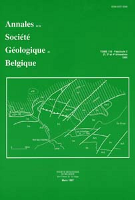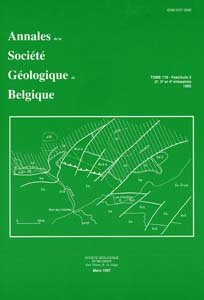- Accueil
- Volume 106 (1983)
- Fascicule 1
- A Lower Liassic offshore bar environment, contribution to the sedimentology of the Luxemburg Sandstone
Visualisation(s): 413 (13 ULiège)
Téléchargement(s): 351 (4 ULiège)
A Lower Liassic offshore bar environment, contribution to the sedimentology of the Luxemburg Sandstone

Résumé
Dans le quart NE du Bassin parisien, les sédiments arénacés des Grès du Luxembourg sont insérés dans le faciès lorrain du Lias inférieur. Les faunes en place ou remaniées indiquent un milieu de dépôt subtidal. Le transport des sédiments à travers le détroit marin du Sillon eifelien vers le Bassin de Paris s'est effectué par des courants tidaux prédominant dans une direction et qui masquent largement les effets des courants de retour. Dans l'ouest et le sud du Grand-Duché ainsi que dans le Luxembourg belge on constate également les effets produits par des courants induits par des tempêtes. L'affleurement de Reckange/Mersch montre les caractéristiques lithologiques et sédimentaires typiques des Grès du Luxembourg. On y distingue six lithotypes principaux. Les teneurs en carbonate peuvent atteindre 80 % et possèdent généralement une origine bioclastique. Bien que des processus diagénétiques soient évidents, ils n'expliquent pas à eux seuls les variations verticales des teneurs en carbonate. Les structures sédimentaires comportent des stratifications obliques à pendage opposé, des surfaces de réactivation sédimentaire, des interlits couplés d'argile ainsi que des flaques argileuses. Ces structures et les populations granulométriques plaident pour un milieu marin peu profond où les remaniements ont été fréquents. Dans ce milieu de "offshore sand waves" s'inscrivent six sub-environnements qui connaissent dans l'aire de répartition des Grès du Luxembourg une distribution caractéristique.
Abstract
In the northeastern quadrant of the Paris Basin the arenaceous sediments of the Luxemburg Sandstone form part of the Lorraine facies of the Lower Lias. The autochthonous as well as the allochthonous fauna elements indicate a subtidal environment. The sediment transport through the marine channel of the Eifel Depression into the Paris Basin has been effected by tidal currents flowing predominantly in one direction. In West- and South-Luxemburg as well as in Belgium these tidal currents effects have been modified by wave (storm) induced currents. The Reckange locality (Luxemburg) for example shows the lithological characteristics and sedimentary features typical of the Luxemburg Sandstone. 6 main lithotypes have been distinguished. The carbonate content of these lithotypes reaches 80 % and usually has its source in bioclastic shell fragments. Even though early to late diagenetic processes are obvious, they are not wholly capable of explaining the vertical variations in carbonate content. The sedimentary structures show herringbone cross sets with bidirectional dipping foresets, reactivation surfaces, tidal couplets and mud drapes caused by tidal currents. The frequent erosive surfaces as well as the grain size distribution curves suggest hydrodynamic conditions of a shallow marine shelf environment with wave influenced reworking and resedimentation. In this offshore sand wave environment 6 subenvironments can be recognised with a characteristic distribution pattern and varying thicknesses in the several areas of the Luxemburg Sandstone.
Pour citer cet article
A propos de : H.P. Berners
Lehr- und Forschungsgebiet allg. und hist. Geologie, RWTH Aachen, Wüllnerstr. 2, 5100 Aachen (Germany).





